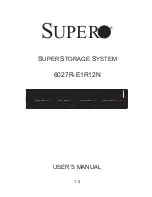Reviews:
No comments
Related manuals for E77S

eServer 200 xSeries
Brand: IBM Pages: 128

eServer 232 xSeries
Brand: IBM Pages: 174

NEAX2000 IVS Series
Brand: NEC Pages: 160

6027R-E1R12N
Brand: Supero Pages: 112

Modbus Server-Cerberus ISO1745
Brand: IntesisBox Pages: 5

ETOS-100XP-E04
Brand: AC&T System Pages: 32

eServer xSeries 205
Type 8480
Brand: IBM Pages: 168

VMS1100
Brand: Arris Pages: 6

DECT Server 2500
Brand: SpectraLink Pages: 27

TS-h2490FU
Brand: QNAP Pages: 58

ZUH2000 -
Brand: Zonet Pages: 2

Proline Promass 500
Brand: TechnipFMC Pages: 32

TN70-B7016
Brand: TYAN Pages: 80

B8236G70W8HR-HE
Brand: TYAN Pages: 84

B5630G62FV10HR
Brand: TYAN Pages: 82

ANTMINER S19 Pro+ Hydro
Brand: BITMAIN Pages: 17

ANTMAINER S19j Server
Brand: BITMAIN Pages: 21

GIRA
Brand: eNet Pages: 7

















